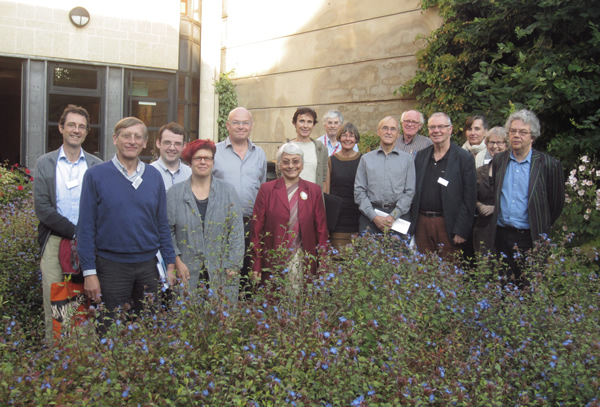Articles and Conference papers
Vowels | Open Syllable Lengthening | Clitics | Text edition| Conference Papers| Workshop Germanic Prosody
Vowels
Johanneke Sytsema, Janet Grijzenhout and Aditi Lahiri (2014). Middle Dutch Back Vowels in Rhymes. Journal of Comparative Germanic Linguistics. 17/2, 157-183.
Abstract: Dutch underwent many changes in its vowel system in the course of its history. One way of exploring the phonology of the vocalic system at an earlier period of the language is to examine rhymes. The rhyming verse which is used in the moral didactic text of Ms. Marshall 29 offered an excellent opportunity to not only establish the differences between Modern and Middle Dutch, but also to trace any variation in the transition period from early to late Middle Dutch. We focused on rounded vowels, which were indicated by seven graphemes: <u>, <uu>, <uy>, <ue>, <oo>, <oe>, and <o>. Our crucial findings are the following: (i) descendants of PGmc. */au/ and /o:/ never rhyme with each other, although they could be spelt in an identical fashion and are pronounced the same in Modern Dutch, which leads us to conclude that the Middle Dutch vowel qualities were different; (ii) descendants of PGmc */u/ became /ɔ/, but when this vowel is lengthened in open syllables, it never rhymes with vowels derived from PGmc. */au/, although they do in Modern Dutch; (iii) although <e> added to a vowel can mark length, in a small subset it must have indicated fronting.
Open Syllable Lengthening
Sytsema, Johanneke & Aditi Lahiri (2018) Open Syllable Lengthening in Middle Dutch: Evidence from Verse. Journal of Germanic Linguistics 30/2, 167-212.
Abstract: This paper attempts to determine a more precise timeline for the onset of Open Syllable Lengthening in Dutch. We examined two late 14th-century Brabantic texts in the Manuscript Marshall 29 (1375 AD), Mellibeus and Saladijn, and compared these with an older Brabantic text Lutgart to ascertain when exactly Open Syllable Lengthening originated in (Brabantic) Middle Dutch. A combination of diachronic correspondences and a careful examination of the texts written in verse during the course of approximately 75 years has helped us to establish the synchronic systems of 13th- and 14th-century Middle Dutch, and, furthermore, has allowed us to determine the onset of prosodic changes such as Open Syllable Lengthening. Orthographic, rhythmic, and metrical evidence from the three texts suggests that the process was incomplete in the earliest period and was finalized in the late 14th century in Brabant, thereby refuting the standard assumption that the lengthening was completed before the onset of Middle Dutch in general.
Clitics
Lahiri, Aditi & Johanneke Sytsema (2018) Metrical Grouping and Cliticisation in Middle Dutch: Evidence from Verse. Transactions of the Philological Society 116/3, 363-382.
Abstract: The syntax-phonology mapping is rarely isomorphic. In Germanic, there is a strong tendency for weak (function) words to encliticise rather than to procliticise. Synchronic and diachronic evidence of encliticisation is available from a number of West and North Germanic languages (cf. Lahiri & Plank 2010). Our goal was to examine metrical grouping in Middle Dutch iambic and trochaic verse, in conjunction with orthographic contractions. Two of our texts, Mellibeus and Saladijn, are from Ms Marshall 29 (c. 1375) and the Lutgart (c. 1300). We asked, to what extent are orthographic contractions isomorphic with cliticisation, and how do they interact with metrical grouping? Furthermore, a close examination of the metre showed, that when properly scanned orthographic sequences of function words need not represent regular cliticisation patterns. First, words can be broken up in prosodic grouping and this holds also for orthographic contractions of function and/or lexical words (alsic < als ic) or (laetti < laet ghi). Second, contractions may not reflect cliticisation. They can be split across feet and the second element can be head of a foot; e.g. dade ic > dadic where ic can head the trochaic foot. Finally, we find that encliticisation is preferred to procliticisation in verse.
Text edition
On the ‘Contents’ page we are providing a diplomatic edition of the full manuscript Marshall 29. We have chosen to edit the text diplomatically to suit our phonological research for which Snellaert’s 1869 critical edition is insufficiently reliable. The text can be viewed per page with manuscript image, alternatively, each of the four Books can be downloaded as an html document.
Conference papers
Sytsema, J.C. (2015) En- versus pro-cliticisation: synchronic and diachronic evidence from Dutch. A Germanic Sandwich 2015, Nottingham
Lahiri, A. (2014) Phrasing and cliticisation in Germanic: Middle Dutch to Modern Dutch. TIE (6th International Conference on Tone and Intonation in Europe)
Lahiri, A. (2014) En- and Pro-cliticisation in Middle Dutch. Workshop on Germanic Prosody, Oxford 2014
Sytsema, J.C. (2014) Vowel Quantity and iambic-trochaic rhythm in Middle Dutch. Workshop Germanic Prosody, Oxford 2014
Sytsema, J.C. (2013) Vowel quality and quantity changes in Middle Dutch. Workshop Metaphony, Meertensinstituut, Amsterdam
Sytsema, J.C. (2014) Clitics and Quantity in Middle Dutch. GLAC 20 (General Linguistics Annual Conference)
Sytsema, J.C. (2014) Vowel changes and Open Syllable Lengthening in Middle Dutch. FGLS 11 (Forum for Germanic Language Studies)
Sytsema, J.C.& A.Lahiri (2013) Vowel changes and metre in Middle Dutch. MfM 21 (Manchester Phonology Meeting)
Workshop Aspects of Germanic Prosody
The workshop Aspects of Germanic Prosody was held at Somerville College, Oxford, September 6-9, 2014. The programme can be found here. For a list of participants, please click here.


